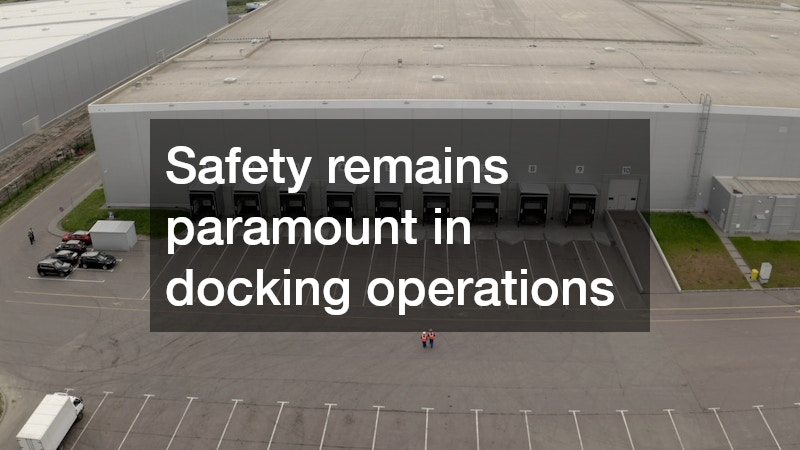In the world of maritime operations, the right docking equipment is essential for ensuring the safe, efficient, and reliable mooring of vessels. Whether you manage a marina, run a commercial port, or simply enjoy boating as a hobby, staying informed about the latest advances in docking technology can make a significant difference. As technology continues to evolve, innovative solutions are transforming traditional docking methods to offer improved safety, durability, and convenience. This article explores some of the top innovations in docking equipment that you need to know about.
Smart Docking Systems
One of the most exciting trends in recent years has been the integration of smart technology into docking equipment. Smart docking systems use sensors, cameras, and automated controls to assist with vessel mooring, making the docking process safer and easier, even for less experienced operators.
These systems can provide real-time data on vessel position, speed, and environmental conditions such as wind or current strength. Automated mooring solutions can then adjust fenders, lines, and dock mechanisms to minimize the risk of damage during docking. Some advanced systems even offer remote monitoring and control, allowing marina operators to assist boaters from a central location.
By reducing human error and improving situational awareness, smart docking systems increase overall safety and efficiency. These technologies are particularly valuable in busy ports or marinas where space is limited and precise docking is crucial.
Eco-Friendly Docking Innovations
Sustainability has become a critical focus in many industries, and maritime infrastructure is no exception. Docking equipment manufacturers are developing eco-friendly solutions designed to minimize environmental impact while maintaining high performance.
One notable innovation is the use of recycled and biodegradable materials for dock components such as bumpers, fenders, and decking. For example, recycled rubber and plastic are increasingly common in fenders, which absorb the impact between the vessel and the dock, protecting both from damage. These materials reduce waste and the need for virgin resources.
Additionally, new dock designs incorporate solar-powered lighting and energy-efficient systems to reduce electricity consumption. Floating docks with environmentally sensitive foundations limit disruption to aquatic habitats and improve water flow. These eco-conscious innovations help marinas meet regulatory requirements and appeal to environmentally aware boaters.
Modular Docking Equipment
Flexibility and adaptability are key advantages of modular docking equipment. Unlike traditional fixed docks, modular systems consist of individual sections or components that can be easily added, removed, or rearranged.
This modularity allows marina operators and waterfront property owners to customize their docking facilities based on current needs and future growth. It also simplifies maintenance and repairs since damaged sections can be replaced without overhauling the entire structure.
Some modular dock systems use lightweight, durable materials like high-density polyethylene (HDPE) or aluminum, which resist corrosion and require minimal upkeep. The ease of installation and reconfiguration makes modular equipment especially attractive for seasonal docks, temporary installations, or expanding marinas.
Advanced Dock Fenders and Bumpers
Protective dock fenders and bumpers are crucial to preventing damage to both vessels and dock structures during mooring. Recent advancements in fender technology have led to more durable, effective, and user-friendly designs.
Modern fenders often use impact-absorbing materials such as foam-filled composites or recycled rubber, which provide superior shock absorption while withstanding harsh marine environments. Some designs feature adjustable or telescoping mechanisms, allowing for customized positioning based on vessel size and dock configuration.
Furthermore, innovations in mounting systems have simplified installation and replacement. Quick-release brackets and modular designs enable rapid adjustments or swaps without requiring specialized tools or lengthy downtime.
These improvements help reduce maintenance costs, extend the lifespan of docking equipment, and enhance overall safety.
Integration with Marina Management Software
Another growing trend is the integration of docking equipment with marina management software platforms. These software solutions offer comprehensive tools for scheduling dock usage, monitoring vessel arrivals and departures, and managing billing and maintenance.
When docking equipment is equipped with sensors and IoT (Internet of Things) technology, it can feed real-time data into these software systems. For example, smart dock locks can automatically record when a boat is secured or released, while sensor-equipped mooring cleats can provide alerts if a line is too loose or tight.
This connectivity enables marina managers to optimize dock utilization, improve security, and streamline operations. It also enhances the customer experience by providing boaters with convenient services like automated check-ins or remote access controls.
Enhanced Safety Features
Safety remains paramount in docking operations, and manufacturers are continually innovating to reduce accidents and injuries. New safety features include improved lighting systems, non-slip surfaces, and ergonomic designs.
LED dock lighting has become a standard innovation, offering bright, energy-efficient illumination that enhances visibility during night operations. Many systems are solar-powered or connected to energy-efficient grids.
Non-slip decking materials and coatings reduce the risk of slips and falls, particularly in wet conditions. Ergonomic features, such as rounded edges, easy-to-grip cleats, and clearly marked pathways, improve user safety and comfort.
Together, these enhancements create a safer environment for dock workers, boaters, and visitors.
The landscape of docking equipment is evolving rapidly, driven by technological advancements and growing environmental concerns. From smart systems that automate and simplify the mooring process to eco-friendly materials and modular designs, these innovations are reshaping the way marinas and waterfront properties operate. Durable materials and enhanced safety features further contribute to creating reliable, user-friendly docking solutions.
Staying informed about these trends can help marina operators, boat owners, and waterfront managers make better decisions, improving safety, efficiency, and sustainability. As innovations continue to emerge, the future of docking equipment promises to offer even greater convenience and performance.

